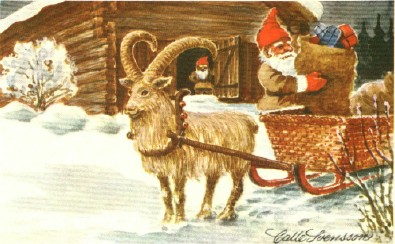The Tomten Page
The tomtes (in Germany, kobolds) are a pre-Christian race of spirit beings well-known to the north Europeans. Generally, they are considered to be spirits of place who become familiars of a household. The tomte is a short (three feet or so) elderly man of unpredictable disposition, attired in grey woolen clothes and wearing a red cap. Unlike their English cousins, the gnomes, who most frequently dwell in the countryside, tomtes reside in towns, houses, barns or cellars. They live only where there is cleanliness, order and discipline. Among the earliest pictures of a tomte is in Carta Marina et Descriptio Septentrioalium (1539) a map drawn by Olaus Magnus, the last Roman Catholic Bishop of Sweden. The tomte is shown cleaning out a stable (he wears the same hat as the Russian knights). The church never succeeded in eliminating these familiars in the popular mind. Busying themselves with work, it is the tomtes who, at harvest time, awaken the sleeping farmer early in the morning with the sound of their threshing. If there is building going on in town, the tomtes can be heard chopping and pounding while the workmen break for lunch and rest.
The tomten has a particular association with the winter solstice, and the pagan celebration of Yuletide. The greeting in Sweden is at this time of year is "God Jul" the midpoint of winter - the cosmic balance between life and death - as suggested in this partial (English) translation of Viktor Rydberg's The Tomten (1881). The illustrations of Jenny Nyström for this work and others fixed the tomten in the popular mind.
Postcard picture by
Calle Svensson |


